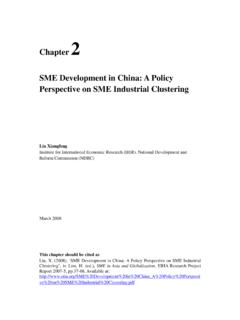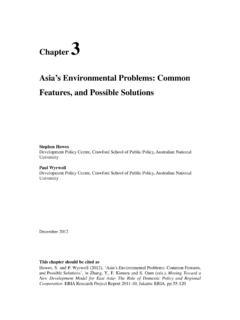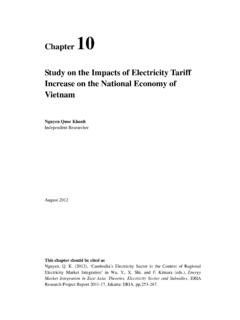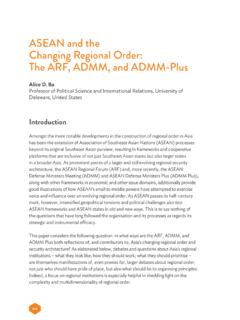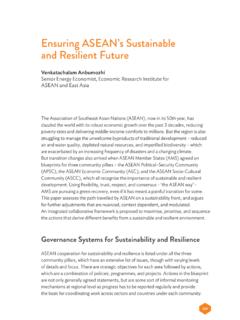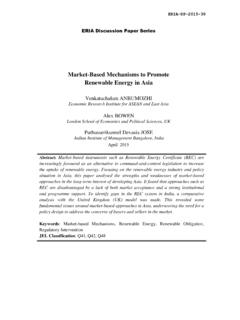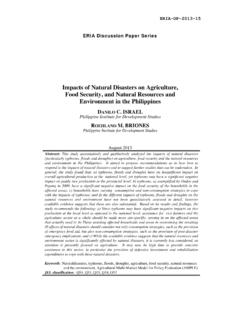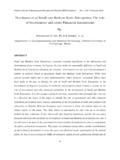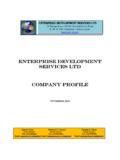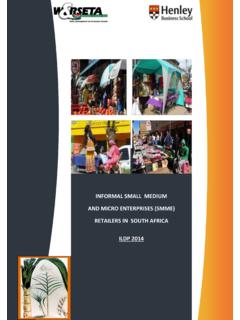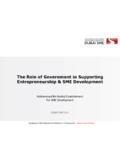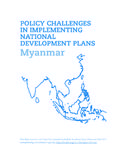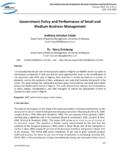Transcription of Cambodia Small and Medium Sized: Enterprises: …
1 Chapter 1 Cambodia Small and Medium sized : Enterprises: constraints , Policies and Proposals for Their development Peter Baily New Zealand Institute of Economic Research (NZIER) March 2008 This chapter should be cited as Baily, P. (2008), Cambodian Small and Medium sized : Enterprises: constraints , Policies and Proposals for Their development , in Lim, H. (ed.), SME in Asia and Globalization, ERIA Research Project Report 2007-5, Available at: 1 Chapter 1 CAMBODIAN Small AND Medium sized : ENTERPRISES: constraints , POLICIES AND PROPOSALS FOR THEIR development Peter Baily Abstract In 2004 the Cambodian government formed the SME Sub-Committee and the SME development Framework was created. The framework is the first attempt by the government of Cambodia to identify barriers and introduce measures specific to promoting development of the country s SMEs.
2 Three main barriers to SME development have been identified; the weak regulatory and legal framework; limited SME access to finance; and a lack of SME support activities. A number of policies have been implemented and recommended to overcome these obstacles to SME development . These include policies to improve the Cambodian business environment. INTRODUCTION Small and Medium sized enterprise (SME) development is crucial for sustained and equitable development of the Cambodian economy. Evidence from more economically developed Asian nations demonstrates that SMEs have considerable potential for driving economic growth. Under the right conditions, entrepreneurs, regardless of background, can start and grow SMEs, generating profits and creating employment opportunities.
3 SMEs drive industrial progress, improve an economy s ability to deal with shocks and are recognised as breeding grounds of As elsewhere in Asia, SMEs make up the vast majority of businesses in Cambodia . Almost 40% of the nation s enterprises have between 10 and 100 employees, and almost 99 percent have between 1 and 100 It is estimated that SMEs provide about two thirds of the country s 2 With the expansion of globalisation, manufacturing SMEs everywhere are facing increasing international competition and need to improve quality and efficiency of output to international standards to survive. The Cambodian business environment needs improving, and SMEs need developing, to be able to compete with imports.
4 Creating a level playing field and encouraging SME development will not only enable Cambodian SMEs to compete successfully in their domestic market; it will also pave the way for their involvement in exporting. The Royal Government of Cambodia (RGC) has stated a commitment to private sector led growth and recognises the importance of SMEs for sustainable and equitable economic development . Although still at the very early stages of implementation, the government has introduced a range of policies focused on SME development . Key to organising SME development strategies has been the forming of the SME Sub-committee in 2004. This paper reports on the growth and current status of Cambodian SMEs, and the main barriers they face to their development .
5 It discusses a number of planned and implemented policies, and recommendations to encourage SME development . 2. CAMBODIAN INDUSTRIAL SMEs History Following independence from the French in 1954 there was a boom in the number of Cambodian industrial SMEs. According to a 1958 government report, in the mid 1950s there were 369 registered SMEs operating in Cambodia . By 1958 there were over Included in this group were assembly plants for Citroen cars, motorcycles and sewing machines, two scooter factories, soap factories, weaving factories, paper and sugar mills and a canning These factories along with much of the country s infrastructure were destroyed as Cambodia got dragged into the deepening regional conflict.
6 During the Khmer Rouge (KR) regime s control of the country from 1975 to 1979 all enterprises were forbidden, and trade, markets and money were Growth The subsequent growth of Cambodian SMEs has been remarkable considering the level of devastation of infrastructure and institutions during the country s recent civil war, and the banning of commerce from 1975 to 1979 under the Khmer Rouge (KR). By the early 1980s agro-industry food processing activities, predominantly rice milling, had started taking place under the cooperative sector. By the mid 1980s a host of Small private enterprises providing basic manufactured goods, such as fish sauce, had emerged to meet growing domestic Nationalised SMEs were sold or leased to the private sector from late 1989, and in 1991 the government introduced a full-scale privatisation programme.
7 Macro-economic stability had been largely achieved by the late 1990s and basic infrastructure and institutions had been rebuilt providing the platform for growth of The number of Cambodian manufacturing SMEs has increased steadily since the late 1980s. A National Institute of Statistics (NIS) survey of industrial firms shows that Table 1: Registered SMEs by industry enterprise type 1998 1999 2000 2001 2002 2003 2004 2005 Food, beverage and tobacco 18,590 19,147 20,152 21,871 21,568 20,869 22,712 23,343 Textile wearing apparel leather 310 39636623821,4171,406 1,672 1,662 Wood products including furniture 895 8148691411313 16 -Paper products printing publishing 26 2324231521 25 31 Chemicals petroleum coal plastics 55 6729727727596 120 153 Non-metallic mineral products 811 777666721757681 680 718 Fabricated metal products 1,375 1,6471,8241,4541,8991,850 2,239 2.
8 222 Other manufacturing 2,035 1,3561,2081,2869761,049 667 618 Total 24,097 24,227 25,406 28,155 26,920 25,985 28,131 28,747 Notes: SMEs in this data set are defined as employing up to 50 people. There are very few enterprises that employ between 50 and 100 people in Cambodia , so not including this group still provides a reasonable estimation of enterprises with fewer than 100 employees. Source: Cambodian Ministry of Industry Mines and Energy, Cambodian National Institute of Statistics Yearbook 2006 4manufacturing SMEs in Cambodia doubled between 1993 and 2000, a compounded growth rate of over ten percent per By the late 1990s registered manufacturing SMEs in Cambodia had grown to number over 24,000, increasing to nearly 29,000 by 2005, (see Table 1).
9 10 The number of registered enterprises is less than half of all Cambodian manufacturing SMEs. Due to barriers to registration and little perceived benefit of joining the formal sector, as discussed further below, many of Cambodia s enterprises have remained informal. At a rough approximation there are over 60,000 industrial SMEs in Cambodia today. The Ministry of Industry Mines and Energy (MIME) estimated that there were at least 30,000 unregistered industrial enterprises in Cambodia in 2005. The Asian development Bank (ADB) estimated informal industrial enterprises with fewer than 50 employees to number about 30,000 in With these two estimates of informal industrial SMEs both close to 30,000 and MIME data showing a further 30,000 registered SMEs in 2005, it is likely that there are at least 60,000 registered and unregistered SMEs in Cambodian today.
10 Involvement in International trade The growth of Cambodian exports has gained momentum as the country has stabilised and foreign investment has increase. Up until the mid 1990s the majority of exports were primary products, such as rubber and timber. Since 1993 there has been rapid growth in the garment industry. However Cambodian SME involvement in manufacturing exports remains Very few Cambodian manufacturing SMEs are involved in exporting. Rather than being processed in Cambodia , most of the country s primary goods, such as cashew nuts and rice paddy, are sent unprocessed to neighbouring countries, where production is more efficient, and then imported back into Cambodia as a finished product.
